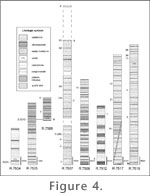|
||||
MATERIAL AND METHODSPreservation of SpecimensMost belemnites studied here have been leached of calcite and, except for occasional calcareous fragments, are present as natural moulds in dark shale, siltstone, and fine sandstone (Middle Jurassic localities – R.7505, R.7506, R.7507, R.7517, R.7519, Q4, 10, 13, 15, 17), or massive grey decalcified sandstone (Upper Jurassic – R.7504, R.7509, R.7512, Q9), and have been studied as latex casts. They vary from almost entire to small fragments, and range from poorly to moderately well preserved. Latex casts of belemnites do not contain all the necessary information on which to base identifications and descriptions. They rarely provide details of internal structures (apical line position, position of the protoconch, details of phragmocone, development of growth stages, changes in guard shape with ontogeny), and surface lines and grooves are often not well preserved. Many specimens present a view normal to bedding planes, and thus record only the details of one flank. In some instances only the gross form of the guard is preserved, often imperfectly, and for most "taxa" few specimens are available and little indication of specific variation can be obtained. The relationship between apical, stem, and alveolar diameters, one way of describing the cross section (a very valuable feature, reasonably consistent within species; Stevens 1965; Challinor 1979, 1996), is difficult to determine in many instances. Where possible, information on cross section has been obtained from undeformed specimens. Some moulds have clearly been deformed (flattened and/or distorted in other ways), most likely by sediment compaction, and cross section and other data either cannot be assessed. Belemnite species are identified with maximum confidence when the known taxon has been described from enough material to recognise most or all of the variation present (including ontogenetic variation), and the unknown material consists of several specimens, preferably complete guards. These constraints have not been met during this work. However, belemnites are uncommon and generally poorly preserved in Latady Group rocks, and the localities are remote and are unlikely to be re-visited in the near to medium-term future. Therefore, we believe description of the material at hand to be justified.
MaterialCollection locality numbers form two groups. Those prefixed by R (e.g., R.7507.9.4a) are from collections by Hikuroa: R = Rothera Station (base from which work was carried out), 7507 = unique outcrop, 9 = unique horizon within outcrop, 4 = individual fossil sample; where several fossil specimens occur on the same rock sample they are labelled a, b, c, etc. The specimens are deposited at the British Antarctic Survey, Cambridge, UK. Those localities prefixed by Q are collections by Quilty (e.g., Q10 = Quilty Locality 10), and individual specimens from those localities (e.g., UTGD (prefix omitted in text) 87347a) are held in the Geology Department, University of Tasmania, Australia. Collection localities are indicated in Figure 1, Figure 2, and stratigraphic positions of those localities are shown in Figure 3, Figure 4. Taxonomy
Brief descriptions that compare or recognise affinities with known taxa, or under open nomenclature, follow. A list of belemnites of uncertain affinity can be found in
the
Appendix. The morphology of the belemnite guard and the terminology used to describe it are detailed in Stevens (1965), and that approach is followed here. The meaning of any undefined terms should be self evident, although one needs elaboration.
Generic ConceptsThe generic concepts used in this study are not necessarily identical with those of other workers. Those of Belemnopsis and Hibolithes have been developed largely from a study of south-western Pacific forms and may be most relevant to them. Only features that have the potential for preservation in casts are discussed. The classification follows Doyle et al. (1994) and is to be the basis of the Coleoidea volume of the Treatise. |
||||

